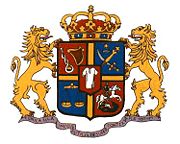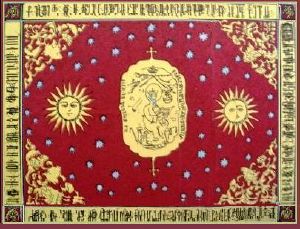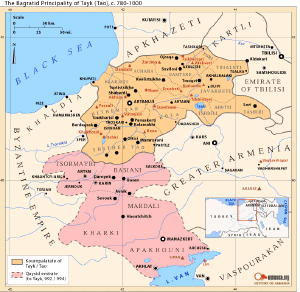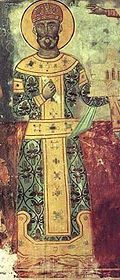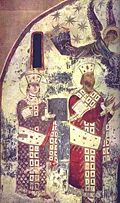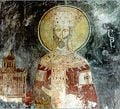Difference between revisions of "Bagrationi dynasty" - New World Encyclopedia
| Line 79: | Line 79: | ||
== References == | == References == | ||
| − | + | ||
| − | *Baddeley, JF, Gammer M | + | *Baddeley, JF, Gammer M.2003. ''The Russian Conquest of the Caucasus.'' London : Routledge ISBN 0-7007-0634-8 (First published in 1908; 1999 edition, reprinted in 2003) |
| − | * | + | *Lang, David Marshall. 1957. ''The Last Years of the Georgian Monarchy: 1658-1832.'' New York: Columbia University Press. |
| − | *Rapp, | + | *Rapp, Stephen H. 2003. ''Studies In Medieval Georgian Historiography: Early Texts And Eurasian Contexts.'' London: Peeters ISBN 9789042913189 . |
| − | *Suny, | + | *Suny, Ronald Grigor. 1994. ''The Making of the Georgian Nation.'' Bloomington, IN: Indiana University Press ISBN 0-253-20915-3. |
| − | |||
== Further reading == | == Further reading == | ||
Revision as of 18:30, 18 July 2008
The Bagrationi dynastybagrationt'a dinastia}}) was the ruling family of Georgia. Their ascendency lasted from the early Middle Ages until the early 19th century. In modern usage, this royal line is frequently referred to as the Georgian Bagratids, a Hellenized form of their dynastic name. The origin of the Bagrationi dynasty is disputed, as well as the time when they first appeared on Georgian soil. Traditional Georgian history writing begins the Bagrationi chronology in the 6th century and relates the family to earlier dynasties. The history of the dynasty is inextricably bound with that of Georgia. They began their rule, in the early 9th century, as presiding princes in historic southwestern Georgia and the adjacent Georgian marchlands reconquered from Arabs. Subsequently they restored, in 888, the Georgian kingdom, which prospered from the 11th to the 13th century, bringing several regional polities under its control. This period of time, particularly the reigns of David IV (1089 - 1125) and his great granddaughter Tamar (1184 - 1213), is celebrated as a "golden age" in the history of Georgia, the era of empire, military exploits, and remarkable achievements in culture. After the fragmentation of their unified feudal state in the late 15th century, the branches of the Bagrationi house ruled the three breakaway Georgian kingdoms – Kartli, Kakheti, and Imereti – until the Russian annexation in the early 19th century. The dynasty persisted as an Imperial Russian noble family until the 1917 February Revolution. The establishment of the Soviet rule in Georgia in 1921 forced many representatives of the family to relocate to Western Europe. One of the branches continues to this day to style themselves as the Royal House of Georgia.
Origins
According to a family legend, taken down by the eleventh-century Georgian chronicler Sumbat Davitis-Dze,[1] and supplied much later by Prince Vakhushti Bagrationi (1696 – 1757) with chronological data, the ancestors of the dynasty traced their descent to the biblical king and prophet David and came from Palestine around 530 C.E. Tradition has it that of seven refugee brothers of the Davidic line, three of them settled in Armenia and the other four arrived in Kartli (a major Georgian region also known as Iberia by Classical authors) where they intermarried with the local ruling houses and acquired some lands in hereditary possession. One of the four brothers, Guaram (died in 532), allegedly gave an origin to a line subsequently called Bagrationi after his son Bagrat.[2] A successor, Guaram, was installed as a presiding prince of Kartli under the Byzantine protectorate and bestowed, on this occasion, with the Byzantine court title of Kouropalates [3] in 575.
This tradition had been given a general acceptance until the early 20th century. [4] While the Jewish origin, let alone the biblical descent of the Bagratids, has been largely discounted by modern scholarship, the issue of their origin still remains controversial. Several Soviet-era historians of Georgia developed a view summarized by N. Berdzenishvili and et al in their standard reference book on the history of Georgia:
| “ | The illustrious dynasty of the Bagrationi originated in the most ancient Georgian district – Speri (today İspir).[5] Through their farsighted, flexible policies, the Bagrationi achieved great influence from the sixth through eighth centuries. One of their branches moved out to Armenia, the other to Kartli, and both won for themselves the dominant position among the other rulers of Transcaucasia.[6] | ” |
Many modern scholars, however, argue the above version, referring to a more complex analysis of primary Armenian and Georgian sources. A genealogical scheme per Cyril Toumanoff is, by far, the most accepted in Western scholarly literature. It affirms that the Georgian Bagratids branched out of the Armenian Bagratid dynasty in the person of Adarnase, whose father Vasak (son of Ashot III the Blind, presiding prince of Armenia from 732 to 748) passed to Kartli following an abortive uprising against Arab rule in 772. Adarnase’s son, Ashot I, attained to the principate of Kartli in 813 and thus founded the last royal house of Georgia. Accordingly, the legend of Davidic origin of the Georgian Bagratids was a further development of the earlier claim entertained by the Armenian dynasty and their apologist Moses of Khorene.[7] Once the Georgian branch, who had quickly acculturated in the new environment,[8] assumed royal power, the myth of their biblical origin helped to assert their legitimacy and emerged as a main ideological pillar of the millennium-long Bagrationi rule in Georgia.[9]
Although certain, generation by generation, history of the Bagrationi dynasty begins only in the late 8th century, C. Toumanoff has demonstrated that the first Georgian branch of the Bagratids may be traced back as far as the second century C.E., when we hear them ruling over the princedom of Odzrkhe in what is now southern Georgia.[10] The Odzrkhe line, known in the medieval annals as the Bivritianis, lasted until the 5th century AD and they cannot be considered as the direct ancestors of the later Bagratids who eventually restored Georgian royal authority.[11]
History
Early Bagrationi dynasty
The Bagrationi family grew in prominence by the time when Georgian monarchy (Caucasian Iberia) had already fallen to the Sassanid Persian Empire in the sixth century, and the leading local princely families were exhausted by the Arab attacks. The raise of the new dynasty was made possible by the extinction of the Guaramids and the near-extinction of the Chosroids,[12] the two earlier Georgian dynasties, with whom the Bagratids extensively intermarried, and also by the Abbasid preoccupation with their own civil wars and the conflict with the Byzantine Empire. Although the harsh Arab rule did not afforded them a foothold in the ancient capital of Tbilisi and eastern Kartli, the Bagratids successfully maintained their initial domain in Klarjeti and Samtskhe and, under the Byzantine protectorate, extending their possessions southward into the northwestern Armenian marches to form a large polity conventionally known in modern history writing as Tao-Klarjeti after its two major provinces. In 813, the new dynasty acquired, with Ashot I, the hereditary title of presiding prince (erismtavari) of Kartli, to which the emperor attached the title of kourapalates.
Despite the revitalization of the monarchy, Georgian lands remained divided among rival authorities, with Tbilisi remaining in the Arab hands. The sons and grandsons of Ashot I established three separate branches – the lines of Kartli, Tao, and Klarjeti – frequently struggling with each other and with the neighboring rulers. The Kartli line prevailed; in 888, with Adarnase I, it restored the indigenous Georgian royal authority dormant from 580. His descendant Bagrat III was able to gather his inheritance in both Tao-Klarjeti and Abkhazian Kingdom, due largely to the diplomacy and conquests of his energetic foster-father David III of Tao.
This unified monarchy maintained its precarious independence from the Byzantine and Seljuk empires throughout the 11th century, and flourished under David IV the Builder (1089 – 1125), who repelled the Seljuk attacks and essentially completed the unification of Georgia with the reconquest of Tbilisi in 1122. With the decline of the Byzantine power and the dissolution of the Great Seljuk Empire, Georgia became one of the most preeminent nations of the Christian East, her pan-Caucasian empire[13] stretching, at its largest extent, from North Caucasus to northern Iran, and eastwards into Asia Minor. In spite of repeated occasions of dynastic strife, the kingdom continued to prosper during the reigns of Demetrios I (1125 - 1156), George III (1156 - 1184), and especially, his daughter Tamar (1184 - 1213). With the death of George III the main male line went extinct and the dynasty was continued by the marriage of Queen Tamar with the Alan prince David Soslan of the alleged Bagratid descent.[14]
Downfall
The invasions by the Khwarezmians in 1225 and the Mongols in 1236 terminated Georgia’s "golden age." The struggle against the Mongol rule created the state of diarchy, with an ambitious lateral branch of the Bagrationi dynasty holding sway over Imereti, western Georgia. There was a brief period of reunion and revival under George V the Brilliant (1299 – 1302, 1314 – 1346), but the eight onslaughts of the Turco-Mongol conqueror Timur between 1386 and 1403 dealt great blow to the Georgian kingdom. Its unity was finally shattered and, by 1490/91, the once powerful monarchy finally fragmentized into three independent kingdoms – Kartli (central to eastern Georgia), Kakheti (eastern Georgia), and Imereti (western Georgia) – each led by the rival branches of the Bagrationi dynasty, and into five semi-independent principalities – Odishi (Mingrelia), Guria, Abkhazia, Svaneti, and Samtskhe – run by their own feudal clans. The Georgian rulers maintained their perilous autonomy during the three subsequent centuries of the Ottoman and Persian domination, sometimes acting nothing but mere puppets in the hands of their powerful suzerains.
The line of Imereti, incessantly embroiled in civil wars, continued with many breaks in succession, and the kingdom was only relatively spared from the encroachments from its Ottoman overlords, while Kartli and Kakheti were subjected to numerous invasions by the Persians, whose efforts to annihilate the refractory vassal kingdoms went in vain, and the two eastern Georgian monarchies, though occasionally losing their independence in the course of their history, survived to be reunified, in 1762, under King Heraclius II, who united in his person both the Kakhetian and Kartlian lines, the latter represented by its junior branch of Mukhrani since 1658.
Last monarchs
Having gained de facto independence from Persia, Heraclius II achieved a degree of stability in the country and established his political hegemony in eastern Transcaucasia. In the 1783 Treaty of Georgievsk, he placed his kingdom under the protection of Imperial Russia. The latter failed, however, to provide a timely help when the Persian ruler Agha Muhammad Khan Qajar attacked Tbilisi in 1795, due largely to the Georgian ties with Russia. After the death of Heraclius in 1798, his son and successor George XII renewed a request of protection from the tsar Paul I of Russia and urged him to interfere in a bitter dynastic feud among the numerous sons and grandsons of the late king Heraclius. The main content of the projected new treaty was to incorporate the kingdom of Kartli and Kakheti into the Russian Empire, preserving its native dynasty and a degree of internal autonomy. The negotiations were still in process,[15] when Paul I signed a manifesto on December 18 1800, declaring the direct annexation of Kartli-Kakheti to the Russian Empire.[16] The document had been held in secret until the death of King George on December 28. His successor, David, was never confirmed by the Russian government as a king, however, and on September 12 1801, the tsar Alexander I formally reaffirmed Paul’s determination, removing the dynasty from the Georgian throne.[16] The Bagrationi princes resisted though divided. Most of them were subsequently arrested and deported from Georgia.[17]
The reign of the house of Imereti came to an end less than a decade later. On April 25 1804, the Imeretian king Solomon II, nominally an Ottoman vassal, was persuaded to conclude the Convention of Elaznauri with Russia, similar to the terms of the Treaty of Georgievsk. Yet the Russian forces dethroned Solomon on February 20 1810. Defeated in a subsequent rebellion to regain the power, he died in exile in Trabzon, Ottoman Turkey, in 1815.[18]
Bagrationis in Russia
{{#invoke:Message box|ambox}} In the Russian Empire Bagrationis became one of the most prominent aristocratic families. The most famous was prince Pyotr Bagration great-grandson of Jesse of Kartli who became a Russian general and hero of Patriotic War of 1812. His brother Roman Bagration also became a Russian general who distinguished himself in the Russo-Persian War of 1826-1828 and was the first to enter Yerevan in 1827. Roman Bagration was also known for his great love of arts, literature and theatre, his home theater in Tiflis (Tbilisi) was among the best in the Caucasus. His son Pyotr Romanovich Bagration became governor of Tver region and later governor-general of Baltic provinces. He was also an engineer-metallurgic who is known for development of gold cyanidation in Russia. Dmitry Pyotrovich Bagration was a Russian general who fought in the First World War in the Brusilov Offensive and later joined the Red Army.
Bagrationis Today
{{#invoke:Message box|ambox}}
The Bagrationi family left Georgia after the Red Army took over Tbilisi in 1921. A descendant of the family, Leonida Georgievna Bagration-Moukhransky, married Vladimir Cyrillovich, Grand Duke of Russia, and is the mother of one of the claimants to the Romanov legacy.
Although the descendants of the last kings still live in Georgia, in 1942 Irakli Bagrationi-Mukhraneli, of the genealogically senior but for a long time nonruling branch of the family, proclaimed himself Head of the Royal House and founded the “Union of Georgian Traditionalists” throughout Europe. His second wife, Maria Antoinetta Pasquini, was the daughter of an Italian Count, but died in 1944. After that he married the Spanish Infanta Maria Mercedes de Baviera y de Borbon, granddaughter of Infanta Maria Teresa of Spain (second daughter of Alfonso XII) and the former Prince of Bavaria, Fernando of Wittelsbach. Nowadays, the Bagrationi-Mukhraneli family descendants live in Rome. The family, currently living in Spain, claims the headship of the Royal House of Georgia. Prince Jorge de Bagration was recognised by the Georgian Government as head of the Royal House in 1991.[19]
Prince Nugzar Petrovich Bagration-Gruzinski of Georgia born August 25 1950, in Tbilisi, Georgia, is also a claimant to the Headship of the Royal House of Georgia.[20] Prince Nugzar is the son of Prince Petre Bagration-Gruzinski of Georgia (1920-1984), a poet and claimant to the Headship of the Royal House of Georgia from 1939 to 1984 and his second wife, Liya Mgeladze (born August 8 1926).
Gallery of Georgian Kings of Bagrationi Dynasty
- Davit ashmashenebeli.jpg
David IV of Georgia
- Georgia-Lasha.jpg
George IV of Georgia
- GeorgeBagrationiXI.jpg
George XI of Kartli
- AlexanderBagrationi.jpg
Alexander Bagrationi
- Erekle ii.JPG
Erekle II
See also
- List of Bagrationi rulers of Georgia
- Bagration-Davitashvili
- Online Gotha
- http://www.chivalricorders.org/royalty/gotha/bagrthis.htm Bagrationi Dynasty
Notes
- ↑ Davitis-Dze, Sumbat. 2003. The Life and Tale of the Bagratids (ცხოვრებაჲ და უწყებაჲ ბაგრატონიანთა ჩუენ ქართველთა მეფეთასა) Tbilisi: Mecniereba., see Suny (1994), p. 349; Rapp (2003), p. 337
- ↑ The earliest Georgian forms of the dynastic name are Bagratoniani, Bagratuniani and Bagratovani, changed subsequently into Bagrationi. These names as well as the Armenian Bagratuni and the modern designation Bagratid mean "the children of Bagrat" or "the house of/established by Bagrat".
- ↑ From the time of Justinian I, the dignity of Kouropalates (Greek: κουροπαλάτης, i.e., chancellor) was one of the highest in the Byzantine Empire, reserved usually for members of the Imperial family. Its frequent conferment upon various Georgian and Armenian dynasts emphasizes their importance in the politics of those times. Suny (1994), p. 348
- ↑ Suny (1994), 349
- ↑ Centered on the modern-day district of İspir, northeastern Turkey, this province is sometimes thought to have been the cradle of the Georgian people (Suny [1994], p. 11). It lay in what is frequently referred to as the Armeno-Georgian marchlands where the two communities coexisted and intermingled for several centuries, but the Georgian Speri and the Armenian Sper may not always be absolutely identical (cf. Tao and Tayk, Rapp [2003], p. 14.).
- ↑ Berdzenishvili et al, Istoriia Gruzii, p. 129, cited in: Suny (1994), p. 349
- ↑ Toumanoff, C. Iberia on the Eve of Bagratid Rule, p. 22, cited in: Suny (1994), p. 349
- ↑ Rapp (2003), p. 169
- ↑ Rapp (2003), p. 234
- ↑ Toumanoff, C. Studies in Christian Caucasian History, p. 316, cited in: Rapp. 2003., p. 145
- ↑ Rapp. 2003., pp. 218, 249
- ↑ Suny (1994), p. 29
- ↑ Georgia. Encyclopedia Britannica online. Retrieved July 18, 2008.
- ↑ According to Prince Vakhushti, David Soslan’s ancestry traced back to the Georgian refugeee prince David, a grandchild of George I of Georgia (1014 - 1027) and his Alan wife Alde.
- ↑ Lang (1957), p. 242
- ↑ 16.0 16.1 Treaty of Giorgievsk. Encyclopedia Britannica online. Retrieved July 18, 2008.
- ↑ Lang.1957., p. 252
- ↑ Suny, p. 64; Baddeley, Gammer. 1908., pp. 66, 78.
- ↑ "Prince George Bagration of Mukhrani, Claimant to the throne of Georgia who became well known in Spain as a motor racing and rally driver", The Times, 2008-02-02. Retrieved 2008-02-09.
- ↑ Online Gotha
ReferencesISBN links support NWE through referral fees
- Baddeley, JF, Gammer M.2003. The Russian Conquest of the Caucasus. London : Routledge ISBN 0-7007-0634-8 (First published in 1908; 1999 edition, reprinted in 2003)
- Lang, David Marshall. 1957. The Last Years of the Georgian Monarchy: 1658-1832. New York: Columbia University Press.
- Rapp, Stephen H. 2003. Studies In Medieval Georgian Historiography: Early Texts And Eurasian Contexts. London: Peeters ISBN 9789042913189 .
- Suny, Ronald Grigor. 1994. The Making of the Georgian Nation. Bloomington, IN: Indiana University Press ISBN 0-253-20915-3.
Further reading
- A. Khakhanov. "Histoire de la Georgie," Paris, 1900 (in French)
- A. Manvelichvili. "Histoire de la Georgie," Paris, 1951 (in French)
- A. Manvelishvili. "Russia and Georgia. 1801-1951," Vol. I, Paris, 1951 (in Georgian)
- K. Salia. "History of the Georgian Nation," Paris, 1983
- Kartlis Tskhovreba, vol. I-IV, Tbilisi, 1955-1973 (in Georgian)
- P. Ingorokva. Giorgi Merchule (a monograph), Tbilisi, 1954 (in Georgian)
- E. Takaishvili. "Georgian chronology and the beginning of the Bagratid rule in Georgia".- Georgica, London, v. I, 1935
- Sumbat Davitis dze. "Chronicle of the Bagration's of Tao-Klarjeti," with the investigation of Ekvtime Takaishvili, Tbilisi, 1949 (in Georgian)
- "Das Leben Kartlis," ubers. und herausgegeben von Gertrud Patch, Leipzig, 1985 (in German)
- V. Guchua, N. Shoshiashvili. "Bagration's".- Encyclopedia "Sakartvelo," vol. I, Tbilisi, 1997, pp. 318-319 (in Georgian)
External links
Credits
New World Encyclopedia writers and editors rewrote and completed the Wikipedia article in accordance with New World Encyclopedia standards. This article abides by terms of the Creative Commons CC-by-sa 3.0 License (CC-by-sa), which may be used and disseminated with proper attribution. Credit is due under the terms of this license that can reference both the New World Encyclopedia contributors and the selfless volunteer contributors of the Wikimedia Foundation. To cite this article click here for a list of acceptable citing formats.The history of earlier contributions by wikipedians is accessible to researchers here:
The history of this article since it was imported to New World Encyclopedia:
Note: Some restrictions may apply to use of individual images which are separately licensed.
